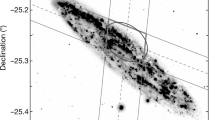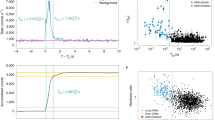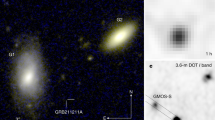Abstract
The γ-ray burst history of GBS0526–66 is unique among observed burst sources1 being that of the brightest burst on record (5 March 1979) and one of only two from which recurrent bursts (at least 15 of similar temporal and spectral pattern) have been observed (though much less intense2 than the first), and the only one whose source direction coincides with that of a previously known object—its 0.1 arc min2 error box lies within the supernova remnant N49 in the Large Magellanic Cloud3. We have found evidence for a pattern in the recurrence times of these bursts, showing an apparent period of 164 day, which we suggest reflects periodic accretion to a neutron star from an eccentric (e ∼ 0.9) binary companion. We propose that this system drives two types of bursts: (1) the relatively frequent but weak recurrent bursts produced by either magnetospheric gating, or thermonuclear runaway, of periodically accreting matter around the neutron star, and (2) the much rarer intense bursts, like that of 5 March 1979, produced by tidally-triggered star quakes.
This is a preview of subscription content, access via your institution
Access options
Subscribe to this journal
Receive 51 print issues and online access
$199.00 per year
only $3.90 per issue
Buy this article
- Purchase on Springer Link
- Instant access to full article PDF
Prices may be subject to local taxes which are calculated during checkout
Similar content being viewed by others
References
Cline, T. L. Am. Inst. Phys. Conf. Proc. 77, 17–33 (1982).
Golenetskii, S. V., Ilyinskii, V. N. & Mazets, E. P. Nature 307, 41–43 (1984).
Cline, T. L. et al. Astrophys. J. Lett. 255, L45–L48 (1982).
Mazets, E. P. et al. Astrophys. Space Sci. 80, 3–143 (1981).
Mazets, E. P., Golenetskii, S. V., Guryan, Yu. A. & Il'inskii, V. N. Astrophys. Space Sci. 84, 173–189 (1982).
Ferraz-Mello, S. Astr. J. 86, 619–624 (1981).
Mazets, E. P., Golenetskii, S. V., Il'inskii, V. N., Aptekar', R. L. & Guryan, Yu. A. Nature 282, 587–589 (1979).
Ramaty, R., Lingenfelter, R. E. & Bussard, R. W. Astrophys. Space Sci. 75, 193–203 (1981).
Ramaty, R. et al. Nature 287, 122–124 (1980).
Woosley, S. E. Am. Inst. Phys. Conf. Proc. 77, 273–292 (1982).
Colgate, S. & Petschek, A. Astrophys. J. 248, 771–782 (1981).
Lamb, F. K. Am. Inst. Phys. Conf. Proc. 115, 179–214 (1984).
Helfand, D. J. & Long, K. S. Nature 282, 589–591 (1979).
Pedersen, H. et al. Nature 312, 46–48 (1984).
Author information
Authors and Affiliations
Rights and permissions
About this article
Cite this article
Rothschild, R., Lingenfelter, R. A 164-day period in γ-ray bursts from GBS0526–66?. Nature 312, 737–740 (1984). https://doi.org/10.1038/312737a0
Received:
Accepted:
Issue Date:
DOI: https://doi.org/10.1038/312737a0
Comments
By submitting a comment you agree to abide by our Terms and Community Guidelines. If you find something abusive or that does not comply with our terms or guidelines please flag it as inappropriate.



